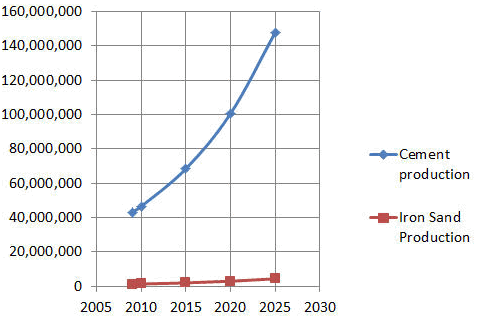THIS POST
WAS ORIGINALLY PUBLISHED MAY 23, 2011
Iron Ore in Indonesia: Much Ado About …? – Final Part
Here I would
like to show, that despite strong external demand, internal Indonesian industry
may consume a lot of iron ore production. As I mentioned before, Indonesia has 362,564,042
tons of primary iron ore deposits – with projected exploitation for 52
years. In the previous post I showed some data on the available types of ore.
Here is what this is intended to be used for.
There is a
requirement of 4.5 million tons of primary iron ore (hematite
or magnetite) that is needed to meet national crude steel capacity (6.5 mill.
tons/year) and national sponge iron production capacity (2.3 mill. tons/year) –
thus amount of primary iron ore that should be supplied to cover the
sponge iron shortage will be 6.94 million tons per year.
According to the Ministry of
Industry the projections for the steel industry requirements look like this:
Iron sand in Indonesia is
used for cement industries. Projections show that the iron sand production lags
as compared to demand:
Laterite iron ore (limonite)
mostly is happening as nickel mines over layer or overburden -- has low iron
content; thus it was not utilized yet as raw material for steel industries.
However, for the future, major Indonesian producers of nickel (PT. INCO and PT. Antam Tbk) are planning to carry out hydrometallurgy process for the limonite ore
which is lower cost in energy as well as capable to treat lower content of
nickel in the ore. Another good potential for limonite is the use as coal
liquefaction catalyst. This graph shows projections of Indonesia limonite
consumption for coal liquefaction.
Thus, there is a
good reason to believe that iron ore shall be in high demand internally for the
nearest years. Some of investors might be cooled off a bit by the fact that according
to the current legislation after five years of operations the iron ore produced
should stay in the country and is prohibited from export. The data
above shows the internal demand. Therefore it is very worthwhile to
make a conclusion that investments in iron ore in Indonesia are really
attractive – both from the international commodity market perspective, and from
internal demand.





No comments:
Post a Comment